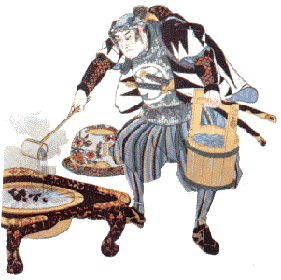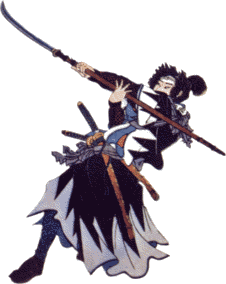| "Never mind the
length of the saber if the man is unaware of its virtue." (Chinese
Proverb) I tried, in the two preceding reflections, to draw your attention to the importance of a global solution for the techniques of close combat. It doesn't matter if they are "empty hand" (because I consider the body to be a weapon) or with weapons (old or modern), or possibly any other common objects one could be equipped with, the techniques are always only expressions of a will of action. I have in mind a concept of defense (and not of attack) which is built starting from a behavior of prevention. To do everything you can to avoid violent confrontation, a behavior which leads out of the situation which has been suddenly created. Thus it is necessary to mention and understand the old proverb: "A wise man is never in a place where a fight starts." This concept calls for a mental attitude which gives one the possibility to make a good choice, at the right time, assuming full responsibility. One needs to consider everything, to find the right cause in order to make the best determination for a reasonable and credible response (if necessary) in a situation face-to-face with an aggression. This is to have the best possible "weapon", which is always adequate, initially to prevent, then to dissuade, and as a last resort to repress. Obviously, that requires a complete control at any moment and the possession of the "right spirit", nothing more than a return to the true sources of practicing Martial Arts. From this point of view the sporting practice, without underestimating it, remains a pale practical substitution, once we have had a glance at the true stakes. Whoever has accepted the idea to turn himself/herself entirely into a weapon, which he/she is responsible for, must have the ability to manage his/her effectiveness. Sometimes that assumes a detention to certain extent, although the image this could create in the public eyes may not seem to be "politically correct"… What I would like to point out is that there are certain awakenings, worthy to be mentioned, that have nothing to do with the so called "combat" sports, where bodies and spirit are literally sharpened by an orientation toward a specific "prize" in order to give them "warlike edge". I want to take a note and make clear that the forging mill of this "weapons" goes hand to hand, inseparably attached to a code of rules and ethics. After this has been noted firmly once again, it is interesting to take a look at a certain research and conclusions that come from fields different than the traditional dojo, but can be applied perfectly to work in the latter without betraying neither the traditional spirit nor the traditional technical groundwork. This slow, and careful synthesis, ready to be enriched unceasingly, gives the techniques of the "empty hand" (the techniques of the type "Kara") an updated image and a better credibility in the current world. |
|
|
Among the many new forms of approach to the close combat, I will concentrate on the first, basic essential of this true, in-depth work: A mental behavior which should be present as well in the everyday life. It will just have a stronger reason when a "problem" is specified. At this point we approach the Budo concept of "zanshin" - translated as "vigilance". However, it appears to be more flexible and more dynamics in some cases. It is called "Code of the colors", a kind of scale in vigilance being able to emerge without delay in case of total engagement. It is a concept which starts with the diffuse feeling of a possible threat and ends with the elimination of the danger. |
 |
|
Without this essential
control over the intensity of the reaction (which is in fact the
contribution of this "weapon"), the reaction would be replaced
by an involuntary reflex which could be very dangerous. In the same time
that will eliminate the idea of the existence of this "weapon".
It is true that this "code of the colors" is also known among
certain people of different spheres outside of the dojo, and it depends
greatly on the level of comprehension (plain intellectual) and perception
(ability to feel and detect), which require particular conditioning and
constant effort. This code manages to "rise to power" during
reaction face-to-face with a danger and it places a successive threshold
according to how real the danger is and what is the extent of the threat.
This is the progressive and strong acquisition of particular state of mind
necessary to achieve victory (or to eliminate the threat), from the moment
of detecting and contact with the danger until the final solution of the
problem. With other words, from the moment of approaching the inevitable
danger, through the release of actions considered to be necessary to
manage the situation, until finally it is over, the stress is behind and
we are back to the state of calmness. To understand it better we can
associate a convenient color to each mental stage of feelings: before,
during and after confrontation with a specific threat. An association
which can be conveniently applied not only in a case of any form of
danger, but in the everyday life, on the road, at work…
Initially there is the
WHITE. It corresponds with the stage of total relaxation, similar to the
state of sleep, but also as in the moments when a person is "elsewhere",
lost in his thoughts. When one misses some moments… (Many have
experienced the "white" stage when driving their cars in the
evening after a long day, extremely tired…). Comfortable, but dangerous
attitude: anything can strike from anywhere and definitely surprise us. The YELLOW color would be
the one necessary to stay with when someone decides to go into the outside
world. The person is awaken, alert, the attention is high without
particular object. Doesn’t expect anything specific, but if needed he
can react quickly and without idle period. One is in the stage of "zanshin"...
This is the normal state of mind without tension or worries, without
anything to make you anxious. This is just the normal, "banal"
everyday life. But, the world could be shaken in a split second. |
|
|
It is the ORANGE stage where things a taking shape. One suddenly gets the impression that something eventually could or it is coming to strike. He starts to detect signals of danger. That is the pure intuition which invades the mind in certain situations, times or places. For example: When someone is right across the street of an abandon neighborhood, or in the subway in a completely empty train, or when confronted by the ambiguity actions of certain individuals, or when one is on the road behind a driver with a dubious behavior, etc. Well, certainly it isn’t quite possible to always avoid being on a spot where could be a problem. |
|
|
Then one starts to focus his attention, seeking the potential danger, which is still vague. But he is already on guard, already stressed, the heart beats a little quicker, the blood pressure goes up. He cannot be completely surprised anymore. He can even start anticipating certain possibilities and think of eventual tactical moves. But this is still just a fuzzy impression… he could be mistaken… and again, with fair amount of relieve, "go down" to the "yellow" stage. Never mind the anticipation. Nothing happens. In the opposite case the danger takes a
precise shape. It already does have a face. It is impossible to escape or
to reverse the situation. Nothing more can be done: the confrontation is
unavoidable. He reaches the RED stage… Even if the conflict with the
approaching adversary remains, by any chance, only on a verbal level (insults,
threats), this is already dangerously close. The concentration must run
extremely high. An error in assessing the level of threat, or the
distance, or the timing of the reaction, if one takes any kind of wrong
decision there won't be a second chance… The sudden, brutal, targeted
assault is generally faster then the defense reaction. Adrenaline streams
through the arteries. The heart now beats extremely fast. Do not panic!
Don't let yourself go down the road of the uncontrolled reflex. Avoid this
trap and remain firmly on your feet… Because at this moment the
"combat" has already begun in your head, but the body can still
remain perfectly motionless and eventually avoid the upcoming threat by
adopting an attitude of "high profile". For example: By taking a
normal position of natural guard, instead of falling in "kamae"
(a traditional low attack or defense position), that could make the
opponent guess that you are not really hostile, so he will not take you as
a threat on his turn which can provoke him to start the action. It will be
wiser to assume just a natural position, ¾ facing the opponent, with arms
crossed in front, from which one can easily move very quickly and execute
a traditional technique if needed. One can still manage to stop, step
back, withdraw, break the contact, and go down to "orange". Then,
once a reasonable distance is set, get back to the "yellow"
stage. (Theoretically it is always the same when one comes that close to
an incident.) It is necessary to be able to turn around and calm down as quickly as one "was ridden in power". This rapid climbing and de-escalation of the will of reaction is conditioning the quality of the personal behavior. It ensures control of the gesture by one's spirit ("edge", but only if I decide that…). The application of the code of the colors is an illustration of the principle of preserving the energy and maximizing the effectiveness in the duration of a confrontation (sometimes it can last longer and become complicated). One should always try "to keep his cool". Nobody said that is an easy task, if you are already in the "fire of the action"! |
|
| The code of the colors outlines how the physical and mental engagement progresses at the time of a real confrontation (on the level of survival). It resembles nothing of the tension you can read in some moments on the faces of certain followers of the combat sports. There is complete safety at first because of the conventional rules, followed by the explosion of violence at the "hajime": one would be rather in the "red" from the beginning until the end. The code of the colors has all nuances. It calls upon the intelligence, the sensitivity, and the realism. It also calls for detailed determination of the proportions of the reaction which must remain completely within the boundaries of the Law governing the complex field of the self-defense. | |
